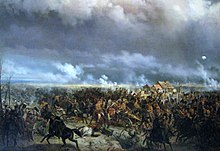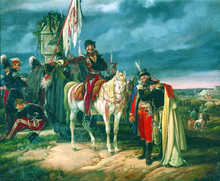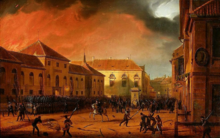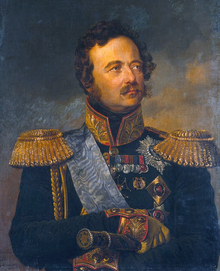November uprising
The November uprising of 1830/1831 (also known as the Polish-Russian War 1830/1831 or the Cadet Uprising ) was the first major uprising in Poland aimed at the country's independence from the Russian Empire . Poland had been divided among its neighbors in the 18th century and had also fought for its statehood in the coalition wars. After the Congress of Vienna , Tsar Nicholas I was king of the restored Kingdom of Poland , but his regime disregarded the Polish constitution. In the course of the uprising he was declared deposed and a national government was formed. The military conflicts at first went well for the Poles, until they finally succumbed to the superior strength of the Russian army. The initiators and later leaders of the uprising failed to develop the uprising into a national movement. Since there was no prospect of social improvement for the peasantry, they followed the events largely uninvolved. The Polish aristocracy and the bourgeoisie also did not stand united behind the movement. After the defeat, many supporters of the uprising emigrated. Poland lost its constitution completely and civil rights were restricted.

"In the name of God for our and your freedom"
prehistory
After his accession to the throne in 1825, Nicholas I promised to recognize the constitution of 1815. At the same time, however, he also made it clear that he regarded the Polish eastern territories as parts of Russia. Russification measures began there . The Lithuanian army was henceforth commanded by Russian officers. The Vilnius University was transformed according to Russian ideas. Pressure was exerted on the United Church affiliated with Rome with the aim of uniting it with the Russian Orthodox Church .
Connections from those involved in the Russian Decembrist uprising reached Poland and the Tsar put pressure on the Polish Senate as the highest court to punish those responsible. The latter refused to condemn efforts to restore Polish territory within the borders of 1794 as high treason, and in 1828 imposed only minor penalties for secret grouping. In Poland itself this intensified the independence movement and the formation of secret societies. As a result, violations of the Russians against the constitution of 1815 were complained. The situation was made worse by price rises and poor harvests. Nicholas I felt the displeasure when he came to Warsaw for the coronation in 1830. When he opened the Sejm , there were calls for reforms in the peasant question and the rights of the Jews. A liberal education policy and the abolition of censorship were called for.
Another aspect was the revolutionary movements of 1830 in France , Belgium and the Papal States . Nicholas I responded by trying to mobilize the Holy Alliance against it. According to rumors in Warsaw, he planned to intervene in Western Europe with the army of the Kingdom of Poland. Instead, Russian troops should move into Poland. Fear spread among Poles that the Russian ruler might take the opportunity to overturn the 1815 Constitution and the country's autonomy.
Start of movement
The first supporters of the November uprising of 1830/31 were not members of the political leadership of the kingdom, but a relatively small group of young conspirators, above all cadets from the Warsaw Ensign School, among them the young Ludwik Mieroslawski , who in later uprisings, not only in Poland, should play an important role. One of the spiritual leaders was the most important historian in Poland, Joachim Lelewel , who first entered the Polish national government and later became president of the Polish National Committee in Emigration.
On the evening of November 29, 1830, a group of conspirators attacked the Belvedere Palace in Warsaw with the aim of killing the de facto viceroy Konstantin Pavlovich Romanov , the tsar's brother. The uprising did not break out spontaneously, but it was poorly planned. Therefore the attack on the governor did not succeed and Constantine was able to escape from the city with the Russian troops. A crowd stormed the arsenal , armed themselves and took control of the northern part of Warsaw.
Now high Polish officers and leading politicians began to take part in the uprising. The princes Franciszek Ksawery Drucki-Lubecki and Adam Jerzy Czartoryski tried to put an end to the unrest and negotiated with the Grand Duke. In December 1830, the "Patriotic Society" formed a political force that pursued a strictly anti-Russian course and organized demonstrations.
Deposition of the Tsar
On December 3rd, a provisional government of the kingdom was formed. Józef Chłopicki became the army commander in chief. He fought all revolutionary movements and declared himself a dictator on December 5th. He was confirmed in this capacity by the Sejm, which met on December 18. Chłopicki did not believe that a Polish victory would be possible and therefore tried to negotiate with the Russians to obtain concessions for Poland. He promised the restoration of peace and order, demanded the cession of the formerly Polish territories from Russia and the respect of the constitution of 1815. When Nicholas I refused to accept this and demanded the submission of the rebels, Chłopicki also resigned because of internal disputes. January 1831 back. In its place, the Reichstag appointed Prince Michał Gedeon Radziwiłł as Commander-in-Chief. The tsar's demand for the insurgents to surrender resulted in the Sejm declaring Nicholas I and the “ Romanov dynasty deposed” on January 25th .
The move towards independence meant that the conflict not only remained a problem for the Russian Empire, but that it threatened the international system of the Congress of Vienna . In particular, Prussia and Austria, as the other two powers involved in the partition of Poland, showed solidarity with Russia.
Development inside
On January 30th, a Polish national government was formed. This consisted of five members under the leadership of Prince Adam Jerzy Czartoryski . The government should represent the different political directions in the country. Two of its members stood for a pro-Russia or neutral aristocratic tendency. Two others who mainly demanded legal certainty were representatives of liberalism. Joachim Lelewel ultimately represented the radical national movement. This disagreement in the political leadership has made the chances of success worse.
Unclear ideas about the intention and course of the uprising and sharp contradictions between the individual political directions put a heavy burden on success from the start, while the military situation was initially not unfavorable. Neither the nobility nor the bourgeoisie were ready for an incalculable national uprising. Ultimately, it came down to the attitude of the peasants and in this respect the uprising failed. In the May constitution, the interests of the peasants were by no means taken into account (the peasants formed the largest population group in Poland and would have been indispensable for the success of the uprising). The farmer remained trapped in his feudal system. The magnates (the high nobility) demanded the maintenance of the feudal system, while other aristocratic groups wanted to win the peasants over to the uprising. The result of these conflicts, however, was the peasant's feudal dependence.
Course of war
The Russian army involved in the operations was about 120,000 strong at the beginning of the military conflict in early January 1831. These included 30,000 cavalrymen and 340 guns. The Polish army at that time consisted of about 55,000 men. These included 15,000 horsemen and 140 guns. At the beginning of the Polish offensive at the end of March 1831 the balance of power had shifted somewhat in favor of the rebels. The Russian troops made up 100,000 men and 380 artillery pieces, the Polish troops 80,000 men and 160 artillery pieces. Before the decisive fighting in early July 1831, the Russian army was clearly numerically superior. They were able to muster 135,000 men, while the Poles only had 65,000 men.
The first phase of the uprising, which broke out before the originally scheduled date on the evening of November 29, 1830, went well for the rebels despite some organizational deficiencies and failures.

On February 5, 1831, the Russian army under Field Marshal Diebitsch crossed the border. Diebitsch had his 118,000 men march in various divisions to Warsaw. General Józef Chłopicki had done too little to replenish the Polish troops. Another problem was that the Commander-in-Chief did not show himself to be very capable.
After the insignificant skirmishes at Stoczek, Wawer and Białołęka , the bloody "undecided" battle at Grochów near Warsaw broke out on February 25 . In Warsaw, the close battle led to mass panic. Radziwiłł then resigned from high command, and General Jan Zygmunt Skrzynecki took his place .
The battle of Grochów led to several months' respite for the insurgents, as the Russian commander-in-chief refrained from major maneuvers. Unrest in Lithuania and Ukraine was also a reason . The Poles used the time to strengthen their army and they went on the offensive. The Polish troops defeated the Russians under Geismar one after the other in the battles at Debe Wielkie and Iganie.
On May 26th, the Poles suffered a heavy defeat in the Battle of Ostrołęka . The Russian II Corps (21,000 soldiers, 90 cannons) under Cavalry General Cyprian Kreutz was detached in the direction of the village of Osiek ( Gmina Bulkowo ), while the Rüdiger Corps was concentrated around Radom , where it engaged in fighting with the Polish Corps under General Samuel Różycki got caught.
The Russian army was temporarily unable to carry out important operations due to an outbreak of an epidemic, and even the Russian commander-in-chief Diebitsch-Sabalkanski fell victim to cholera . Field Marshal Ivan Fyodorowitsch Paskewitsch took over in his place at the beginning of June . This went over to the offensive, crossed the Vistula and threatened Warsaw from the west. On the Polish side, Jan Krukowiecki had the supreme command, Kazimierz Małachowski was elected commander of the defense of Warsaw in mid-August , but resigned a few days later, whereupon Henryk Dembiński took over the leadership.
Riots broke out in Warsaw and the national government resigned on August 16. After the battle for Wola on September 6th and 7th, 1831, the city had to surrender to Field Marshal Paskiewitsch on September 8th.
The Polish troops withdrew to the Modlin Fortress . Maciej Rybiński became the new commander in chief . Head of government was Bonawentura Niemojowski . The army was now too weak for new advances. The government and the Reichstag only led a shadowy existence. On October 5th, most of the Polish troops crossed the Prussian border and were interned there. Another part went to Austria.
consequences

Numerous political emigrants from Poland moved through Germany to Western Europe (Great Emigration) . A total of around 50,000 soldiers and politicians left the country. Most of them later returned to Poland. Of an estimated 8,500 permanent emigrants, around 5,700 settled in France. A chair for Slavic language and literature at the Collège de France was established there, to which Adam Mickiewicz was appointed in 1840 .
On the way west, the rebels were warmly welcomed , especially in Saxony , Baden and Bavaria . There was a "Enthusiasm for Poland" and there were many places Poland clubs . The November Uprising was seen as part of a national pan-European movement. At the Hambach Festival in 1832, in addition to the black, red and gold "German" flag, the white and red Polish flag was also hoisted. Of the fraternities which was subsequently bekishe adopted as part of the student dress.
Field Marshal Paskevich, who was made Prince of Warsaw by the Tsar for his victory and made governor and viceroy of Poland, began the Russification of the country. On February 26, 1832, he implemented the Organic Statute that united Poland with Russia. The constitution of 1815 was repealed in favor of the repressive organic statutes. The Polish army was disbanded, individual freedoms and freedom of the press were curtailed. Around 80,000 Poles went to Siberia in handcuffs . The University of Warsaw was closed. From then on, the leading positions in the administration were occupied by Russians.
literature
- Manfred Alexander : Small history of Poland. BpB , Bonn 2005, ISBN 3-89331-662-0 , pp. 198–203 ( series of publications by the Federal Agency for Political Education, 537; updated and expanded edition: Reclam, Stuttgart 2008, ISBN 978-3-15-017060-1 ( Reclams Universal Library, 17060)).
- Helmut Bleiber , Jan Kosmin: Documents on the history of the German-Polish friendship 1830-1832 . Akademie Verlag, Berlin 1982.
- Gabriela Brudzyńska-Němec: Enthusiasm for Poland in Germany after 1830. In: European History Online , ed. from the Institute for European History (Mainz) , 2011, accessed on: November 28, 2011.
- Norman Davies : In the Heart of Europe: History of Poland. 3rd edition, Munich 2002, ISBN 3-406-46709-1 .
- Jürgen Heyde: History of Poland . Beck , Munich 2006, ISBN 3-406-50885-5 , pp. 60-64 (Beck'sche series 2385, C. H. Beck Wissen).
- George J. Lerski : Historical Dictionary of Poland, 966-1945. Greenwood, Westport CT 1996, ISBN 0-313-26007-9 , pp. 391-393.
- Henryk Kocój: Prussia and Germany versus the November uprising 1830–1831. Uniw. Śląski, Katowice 1990, ISBN 83-226-0333-9 .
- Alix Landgrebe: "If Poland didn't exist, it would have to be invented" - the development of Polish national consciousness in the European context from 1830 to the 1880s. Harrassowitz, Wiesbaden 2003, ISBN 3-447-04811-5 (Studies by the Research Center for East Central Europe at the University of Dortmund, vol. 35; detailed bibliography from p. 209 ff.).
Web links
- For the exhibition “Spring in Autumn” at the Museum of European Cultures Berlin
Individual evidence
- ↑ Norman Davies : In the Heart of Europe. History of Poland. Beck, Munich 2000, ISBN 3-406-46709-1 , p. 152.
- ^ Manfred Alexander: Small history of Poland. Bonn 2005, pp. 198-200.
- ^ Manfred Alexander: Small history of Poland. Bonn 2005, p. 201.
- ^ Manfred Alexander: Small history of Poland. Bonn 2005, p. 202.
- ↑ Otto Berndt: The number in the war. Statistical data from recent war history in graphic representation. Vienna 1897, plate 33.
- ↑ Norman Davies: In the Heart of Europe: History of Poland. 3rd edition, 2002, ISBN 3-406-46709-1 , p. 153.



